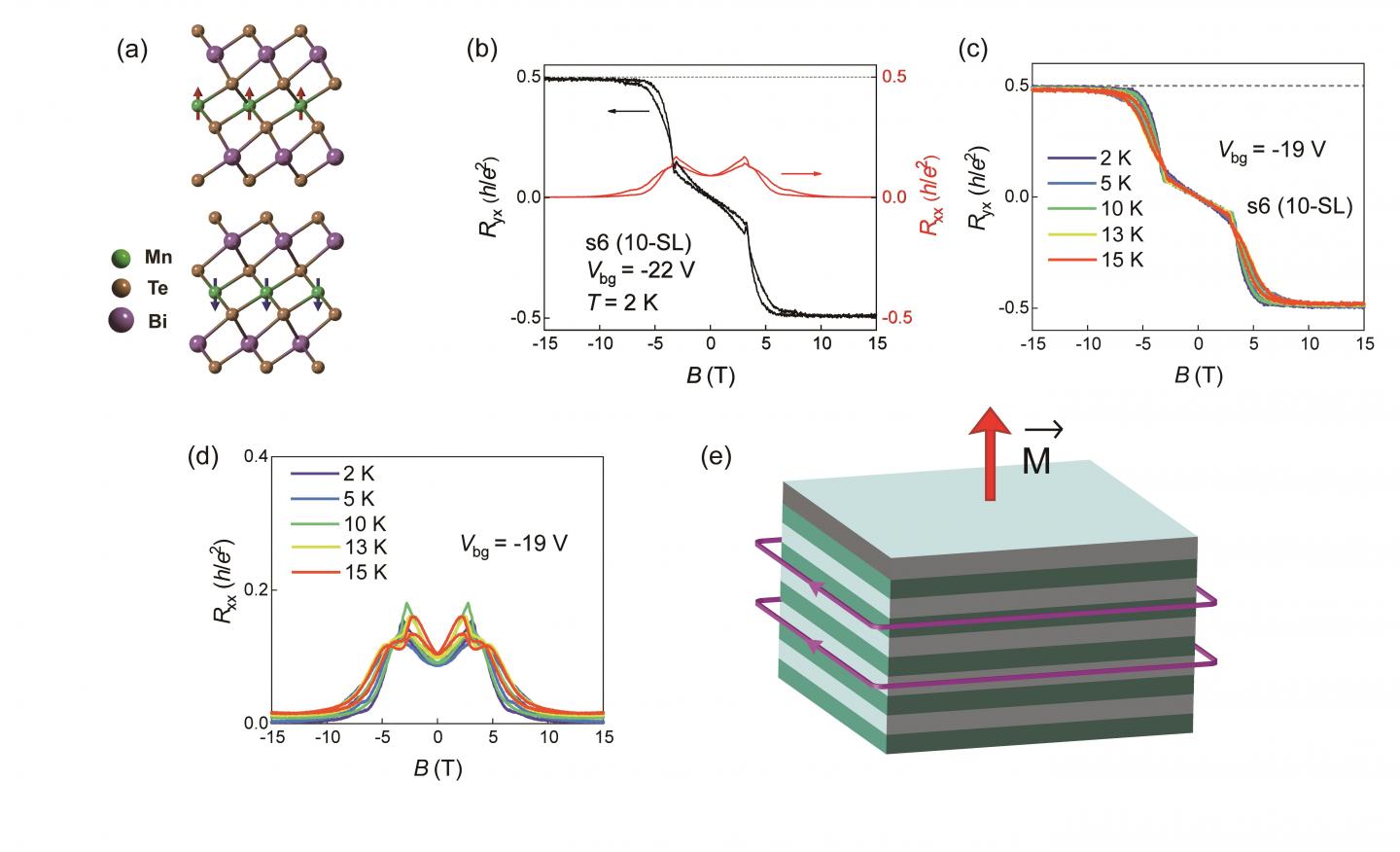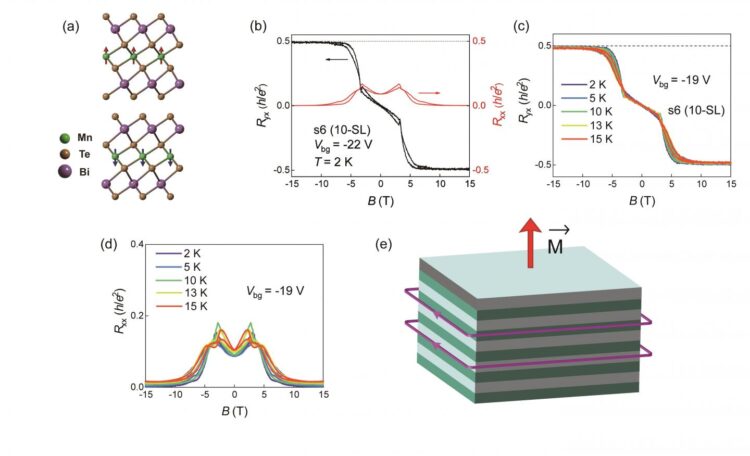
Credit: The International Center for Quantum Materials, School of Physics, Peking University
Quantum Hall effect (QHE) is one of the most important discoveries in physical sciences. Due to the one-dimensional (1D) dissipationless edge states, QHE exhibits exotic transport properties with quantized Hall resistance of h/νe2 and vanishing longitudinal resistance. Here, h is Planck’s constant, ν is Landau filling factor and e is electron charge. QHE usually originates from the formation of remarkable energy gap and the broken time-reversal-symmetry, which requires materials with high mobility, high magnetic field and ultralow temperature. These rigorous conditions greatly limit the deep exploration and wide applications of QHE. In 1988, Haldane theoretically proposed that QHE can be realized without applying external magnetic field, i.e. Chern insulator state or quantum anomalous Hall effect (QAHE). In 2013, QAHE with Chern number C=1 was experimentally observed in thin films of chromium-doped (Bi,Sb)2Te3 at the temperature down to 30 mK. Afterwards, Haldane was awarded the 2016 Nobel Prize in Physics for his early theoretical works on topological phases of matter including the prediction of QAHE. The 1D dissipationless edge states of Chern insulators provide a possible solution to the inevitable heating in integrated circuits. In general, only one 1D dissipationless edge state can be realized at ultralow temperatures in magnetically doped topological insulators, which is far from the application requirements. Therefore, realizing multiple dissipationless edge states and increasing the working temperature of Chern insulator states are not only the most important research topics in physical sciences, but also expected to promote the development of low-consumption electronics and integrated circuits.
Recently, a research collaboration led by Professor Wang Jian at Peking University, Professor Xu Yong and Professor Wu Yang at Tsinghua University has discovered high-Chern-number and high-temperature Chern insulator states in MnBi2Te4 devices, representing a great breakthrough in Chern insulators and topological quantum states.
MnBi2Te4 is a layered magnetic topological material. As shown in Fig. 1a, monolayer MnBi2Te4 includes seven atomic layers, forming a Te-Bi-Te-Mn-Te-Bi-Te septuple layer (SL), which can be viewed as intercalating a Mn-Te bilayer into the center of a Bi2Te3 quintuple layer. MnBi2Te4 exhibits ferromagnetic (FM) order within SL and anti-ferromagnetic (AFM) order between neighboring SLs with an out-of-plane easy axis. Theoretical calculations show that various exotic topological states can be expected in MnBi2Te4, such as QAHE in odd SLs films, axion insulator state in even SLs films, AFM topological insulator at zero magnetic field and magnetic Weyl semimetal under perpendicular magnetic field in bulk. Abundant exotic topological states and layered structure make MnBi2Te4 an excellent platform for observation and modulation of topological quantum states.
The researchers fabricated several MnBi2Te4 devices with different thickness. In 9-SL and 10-SL MnBi2Te4 devices, a Hall resistance plateau with height of h/2e2 accompanied by nearly vanishing longitudinal resistance is observed by applying a perpendicular magnetic field of 5 T, which is characteristic of the Chern insulator with two dissipationless edge states (C=2) (Fig. 1b). More interestingly, the C=2 Chern insulator state in 10-SL MnBi2Te4 device can sustain above 10 K (Figs. 1c, d). This is the first experimental discovery of multiple dissipationless edge states above liquid helium temperature.
The researchers further studied the influence of thickness of MnBi2Te4 devices on Chern number. In 7-SL and 8-SL MnBi2Te4 devices, a quantized Hall resistance plateau h/e2 accompanying with nearly vanishing longitudinal resistance, i.e. Chern insulator state with C=1 is observed. More importantly, the Hall plateau shows nearly quantized resistance even at 45 K in 7-SL MnBi2Te4 device (Figs. 2a-c) and above 30 K in 8-SL MnBi2Te4 device (Figs. 2d-f), which are obviously higher than the Néel temperature (about 22 K) of MnBi2Te4 devices.
The observed high-Chern-number and high-temperature Chern insulator states require applying weak magnetic field due to the antiferromagnetic nature of MnBi2Te4 at zero magnetic field. As the ordinary QHE can also give rise to quantized Hall resistance plateau and vanishing longitudinal resistance, it is necessary to exclude the influence of Landau levels (LLs) induced by external magnetic field on the findings. The researchers firstly estimated the mobility of MnBi2Te4 devices, which is found to be ranging from 100 to 300 cm2 V−1 s−1. Such low mobility requires an external magnetic field higher than 30 T for QHE with LLs to be observed, which is much higher than the quantization magnetic field in our MnBi2Te4 devices. The researchers further demonstrated that the sign of Chern number remains unchanged with the carrier type when applying back gate voltages, unambiguously excluding the possibility of the ordinary QHE with LLs.
The origin of the observed Chern insulator states is revealed by theoretical calculations. Ferromagnetic MnBi2Te4 is predicted to be the simplest magnetic Weyl semimetal, which possesses only one pair of Weyl points (WPs) near the Fermi level. Quantum confinement leads to the Chern insulator state and layer-dependent Chern number in few-layer MnBi2Te4, permitting the existence of multiple dissipationless edge states in the bulk band gap, which is consistent with the experimental findings. The discovery of high-Chern-number Chern insulator state also provides experimental evidence in a way for the magnetic Weyl semimetal state in MnBi2Te4.
The high-Chern-number and high-temperature Chern insulator states discovered in the intrinsic magnetic topological materials will stimulate the exploration on higher temperature and even room-temperature QAHE, and pave the way for great breakthroughs in physics, materials science and information technology.
The paper entitled “High-Chern-Number and High-Temperature Quantum Hall Effect without Landau Levels” was published online in National Science Review (https:/
Noted: Editors’ Choice of Science highlights seven papers from other journals in each issue. This issue includes one paper in Physics.
Media Contact
Xu Haolun
[email protected]
Original Source
http://newsen.
Related Journal Article
http://dx.





